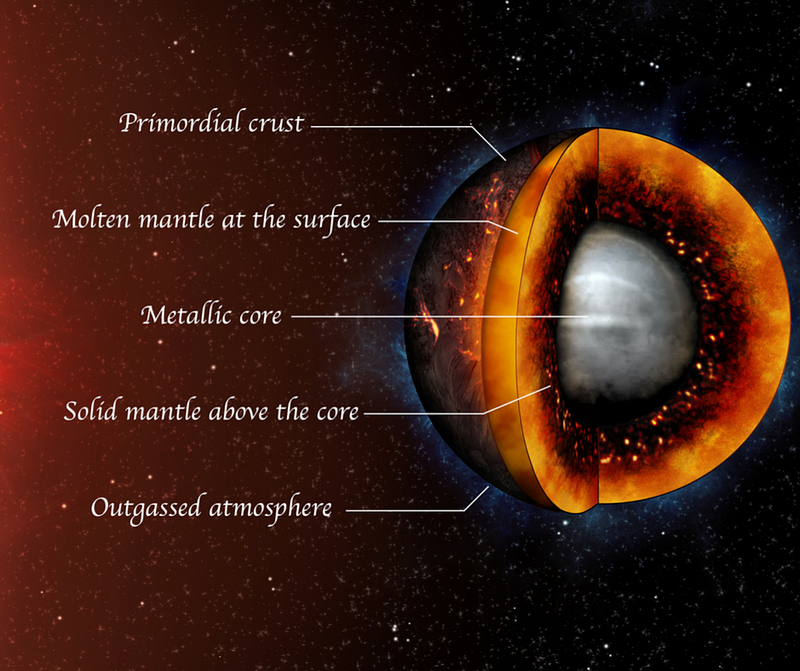Exploring Molten Exoplanets: Insights into Earth-like Worlds
Written on
Chapter 1: Understanding Molten Exoplanets
Research on molten exoplanets surrounding Sun-like stars is shedding light on how Earth-like planets form and develop. A team from the University of Bern has found that if Earth were hot and molten, it would be roughly 5% larger than its current rocky state. Understanding the distinctions between rocky and molten exoplanets is crucial for the hunt for Earth-like worlds orbiting stars beyond our solar system.
Due to their relatively small size compared to other celestial bodies, rocky exoplanets similar in size to Earth are notably challenging for astronomers to detect and study. The identification of such planets around bright Sun-like stars may not be feasible until the anticipated PLATO mission launches in 2026. However, detecting Earth-sized planets orbiting smaller, cooler stars, like the red dwarfs Trappist-1 or Proxima b, is currently achievable.
In fact, focusing on molten exoplanets could enable astronomers to delve deeper into the cosmos and potentially uncover rocky exoplanets akin to Earth.

“A hot, molten rocky planet with a substantial outgassed atmosphere is more likely to be detected by telescopes due to its intense outgoing radiation,” explains Dan Bower, an astrophysicist at the Center for Space and Habitability (CSH) of the University of Bern. Gaining insights into these hot, molten worlds can illuminate how planets like ours originate. Earth, for instance, is composed of remnants of material that weren't incorporated into stars or giant planets.
Bower elaborates, “Any material that doesn't end up in a star or a larger planet might eventually contribute to the formation of a smaller terrestrial planet. We believe that conditions during a planet's formative years significantly influence its developmental trajectory.”
This prompted Bower and his colleagues, primarily from the Planet S network, to investigate the observable traits of such molten exoplanets. Their findings, published in the journal Astronomy and Astrophysics, indicate that a molten Earth would have a radius about 5% greater than its solid counterpart. They attribute this size difference to the contrasting behaviors of solid and molten substances under extreme subterranean conditions.
As Bower notes, “A molten silicate occupies more volume than its solid equivalent, thereby increasing the planet's size.” The current technology allows for measuring this 5% size difference, and upcoming advancements, such as the CHEOPS space telescope set to launch later this year, will further facilitate these measurements.
Recent data suggest that low-mass molten planets sustained by intense starlight could already be cataloged in exoplanet databases. Some may share similar materials with Earth, with size variations stemming from the balance of solid and molten rock.
Bower asserts, “These planets don’t necessarily require exotic light materials to account for the data.” However, even completely molten planets cannot explain the observations of the most extreme low-density exoplanets. The research team proposes that these low-density planets may result from molten planets releasing substantial gaseous atmospheres trapped within their molten interiors, leading to reduced observed density.
Detecting such outgassed atmospheres should be straightforward for the James Webb Telescope, particularly if they orbit cooler red dwarfs and are primarily composed of water or carbon dioxide.
The broader implications of this research highlight its significance in understanding our planet's history, formation, and evolution. Bower states, “We can never witness our own Earth during its hot, molten phase. However, exoplanetary science offers a unique opportunity to observe early analogs of Earth and Venus, potentially enriching our understanding of both Earth and the planets within our solar system. Considering Earth in the context of exoplanets opens new avenues for understanding planetary formation both in our system and beyond.”
Chapter 2: The Role of Exoplanet Research in Understanding Earth
The first video titled "Exoplanet Atmospheres and Life in the Universe" explores the potential for life on exoplanets and the significance of their atmospheres.
The second video, "Earth as an Exoplanet: Using Remote Sensing Data to Find Habitable Worlds," discusses how remote sensing can help identify habitable environments on exoplanets.